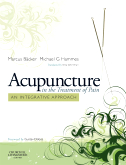|
|
|
| |
 |
|
|

|
 推薦指數:
推薦指數:





|
|
- 內容介紹
|
Acupuncture in the Treatment of Pain - An Integrative Approach
Edited by Marcus Backer, MD and Michael G. Hammes, MD
560 pages
Trim Size 9 11/16 X 7 7/16 in
Copyright 2010
Description
Acupuncture in the Treatment of Pain is aimed at both beginners and experienced practitioners who are treating patients with painful conditions. It provides an integrative approach using conventional and traditional Chinese Medicine in the treatment of pain with acupuncture. It is especially suited for conventionally (western) trained physicians, who are interested in complementary approaches and seek a guideline to judge the potentials and limits of acupuncture in the treatment of pain.
The book consists of two parts. The first part (chapter 2-8) gives the background for both traditional Chinese concepts to pathogenesis, diagnosis and treatment of pain and basics of the conventional, western approach to pain treatment. The second part (chapter 9-17) gives detailed information for the integrative treatment of all common painful conditions. For every single indication, conventional and traditional Chinese treatment options (including Chinese phytotherapy) are shown and the value of acupuncture, scientific data about its efficacy, and its possible mode of action (in western-physiological terms) are discussed.
For all readers this book offers a modern integrative approach, which is based on scientific data and the clinical experience of the authors that Western and Traditional Chinese medicine complement each other and can create synergistic effects.
Key Features
• Attractive 2 colour design
• Written by a team of experts in the field
• Includes more than 175 2 colour illustrations
• Integrates western and traditional Chinese medicine
Table of Contents
PART I: Basics of Western und Traditional Chinese Approach to Pain Therapy
1 Introduction
2 Pain from the western perspective
2.1 Basics and background (bio-psycho-social concept of chronic pain)
2.2 Diagnosis
2.3 Treatment guidelines
2.4 Conventional treatment modalities in pain therapy
2.5 Western naturopathic treatment modalities in pain therapy
3 Pain from the traditional Chinese perspective
3.1 Basics of traditional Chinese medicine theory
3.2 Concepts for the pathogenesis of pain
3.3 Bi-Syndrome
3.4 Prevention
4 Diagnosis in TCM
4.1 Comparison of the perspectives in East and West
4.2 Anamnesis
4.3 Special aspects of physical examination (Tongue and Pulse Diagnosis)
4.4 Differentiation of the syndrome pattern
4.5 Correlation between western diagnosis and traditional Chinese syndrome patterns
4.6 Relevance of syndrome diagnosis for clinical practice
5 Guidelines for the treatment of pain in TCM
5.1 Formulation of the therapeutic principle
5.2 Therapeutic strategies
6 Acupuncture
6.1 Definition
6.2 Neurobiological mechanisms of acupuncture in the treatment of pain
6.3 Indications
6.4 Contraindications
6.5 Side effects
6.6 Technique and practical performance
6.7 Treatment principles
6.8 Moxibustion
6.9 Related Techniques (Dry needling, EA, Ear Acupuncture, Scalp A., Laser, TENS, Neuraltherapy)
7 Channels and important acupoints
7.1 Channels and points
7.2 Acupoints and channels from a western perspective
8 Further treatment modalities in TCM
8.1 Traditional Chinese Phytotherapy
8.2 TCM Dietetics
8.3 Tuina
8.4 Gua Sha
8.5 Qi Gong
PART II: Treatment of painful conditions
9 Head- and facial pain
9.1 General guidelines
9.2 Migraine
9.3 Tension type headache
9.4 Cervicogenic headache
9.5 Temporomandibular dysfunction
9.10 Trigeminal neuralgia
9.11 Atypical facial pain
9.12 Symptomatic facial pain (sinsusitis, dental pain, parainfectious headache)
10 Pain in the locomotor system
10.1 General guidelines
10.2 Cervicocephal Syndrome
10.3 Neck pain
10.4 Shoulder pain (Bursitis subacromialis, Tendinitis calcarea, Impingement S.)
10.5 Epicondylitis humeroradialis
10.6 Tendovagintis and Tendinopathies
10.10 Spondylogenic thoracical pain
10.11 Chronic low back pain
10.12 Ischialgia
10.13 Failed back surgery Syndrome
10.14 Piriformis Syndrome
10.15 Osteoarthritis of knee and hip
10.16 Achillodynia
10.17 Osteoporosis
10.18 Rheumatoid Arthritis
11 Fibromyalgia
12 Visceral pain
12.1 General guidelines
12.2 Angina pectoris
12.3 Thoracic pain of non-cardiac origign
12.4 Gastritis
12.5 Functional dyspepsia
12.6 Irritable bowel Syndrome
12.7 Chronic pelvic pain
13 Neuropathic pain
13.1 General guidelines
13.2 Carpal tunnel Syndrome
13.3 Meralgia paresthetica
13.4 (Post)herpetic pain
13.5 Polyneuropathy
13.6 Complex regional pain Syndrome (CRPS)
13.7 Central pain (post-stroke pain, paraplegia)
13.8 Phantom-limb pain
14 Vascular pain
14.1 General guidelines
14.2 Raynaud Syndrome
14.3 Peripheral arterial occlusive disease
15 Acupuncture in palliative care
15.1 Introduction
15.2 Definitions
15.3 Clinical aspects
15.4 Summary
16 Psycho-vegetative disorders
16.1 General guidelines
16.2 Burn out/ exhaustion/ muscular weakness
16.3 Weakness of the immune system (Recurrent infections)
16.4 Insomnia
16.5 Increased Irritability
16.6 Unspecific vertigo
16.7 Tinnitus
16.8 Depression
16.9 Neuropsychological deficits
17 Psychosomatic aspects in pain therapy
18 The Future
|
|
|

